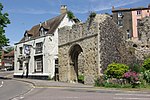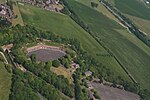St Mary sub Castro, Dover
7th-century church buildings in EnglandChurch of England church buildings in KentChurches in Dover, KentDiocese of CanterburyHistory of Kent ... and 3 more
Infobox religious building with unknown affiliationStanding Anglo-Saxon churchesUse British English from June 2015

St Mary sub Castro (i. e. "St Mary below the Castle"), or St Mary de Castro, or St Mary in Castro ("St Mary in the Castle"), is a church in the grounds of Dover Castle, Kent, south-east England. It is a heavily restored Saxon structure, built next to a Roman lighthouse which became the church bell-tower. St Mary serves the local population and the army, and is the church of the Dover Garrison.
Excerpt from the Wikipedia article St Mary sub Castro, Dover (License: CC BY-SA 3.0, Authors, Images).St Mary sub Castro, Dover
Upper Road,
Geographical coordinates (GPS) Address Website Nearby Places Show on map
Geographical coordinates (GPS)
| Latitude | Longitude |
|---|---|
| N 51.1283 ° | E 1.3233 ° |
Address
Dover Castle
Upper Road
CT16 1HP , Dover
England, United Kingdom
Open on Google Maps











